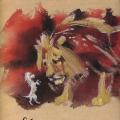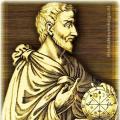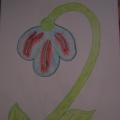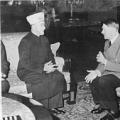Rostokina Valentina Vasilievna
It often happens that a child can count from 1 to 10 just fine, but he can’t find it on his own figure, shown in the picture, cannot. Graphic image numbers for him it is a complex abstract concept. The development of abstract thinking is not a simple process and cannot be done without the help of adults.
Children often get confused numbers, slightly similar to each other, for example 6 and 9, 8 and 3, 4 and 7. And this problem should not be missed in any case. Children need help to understand such complex graphic images for their perception. It will be much easier for the child to remember figure, if he can find its resemblance to any object or animals: 2-flower, 8-tumbler.
I present to your attention didactic game in mathematics"What number is hidden??", which I used in my classes with children when studying numbers.
Target: Development of children's interest, imagination, memory, visual-figurative thinking.
Move: The teacher shows the children pictures. The children look at them. Educator asks: "On what looks like a figure?" and the children call figure.









Thank you for your attention!
Class: 1
Presentation for the lesson
Back forward
Attention! Slide previews are for informational purposes only and may not represent all the features of the presentation. If you are interested in this work, please download the full version.
The purpose of the lesson: introduce the number and number 1.
Tasks:
- Educational: introduce the number and number 1, clarify the concepts of spatial relationships: left, right, middle; strengthen the ability to reason and draw conclusions.
- Educational: Develop speech, cognitive abilities, sustained attention, associative thinking, memory, logical thinking, imagination.
- Educational: Formation of responsibility and interest in mathematics. To cultivate in students a culture of communication, a sense of collectivism, and respect for classmates.
- Health saving: Physical exercise for hands, fingers, exercises for the eyes, general physical exercise, individual work with students, differentiated approach. Multi-level cards.
Equipment: cards with numbers and dots, cards for visual rearrangement of elements, sample tasks, cards for individual work. Computer, projector, screen, presentation as a slide show.
During the classes
I. Org moment.
Slide 1. The long-awaited bell rang and the lesson began. Check your readiness for the lesson: on the desks there is a textbook-notebook, figures, pens and pencils.
Slide 2. Our lesson will be held under the motto: Be careful! You will succeed!
Slide 3 (background)
1. Oral counting.
Frontal: Rhythmic counting. Let's count out loud. Count directly to 10.
Count down from 10.
Individual at the board: The numbers are mixed up. Place the numbers in order from 1 to 10. (Tsvetkov). Let's see if Oleg placed the numbers correctly.
2. Work on the number series.
2 people individual tasks on cards. (Alexandrov, Gadzhiev).
Frontal: Look at the number line. What number comes after the number 2? 5?
What number comes before the number 4? 7?
What number is between 3 and 5? To the right of 7? To the left of 4?
3. Work on the number series 2 4 6.
Ind: 2 people individual tasks on cards. (Yorov, Vrabie).
Frontal: Attention to the board. Consider the number line. Think about how it's composed. Continue it for two numbers. Hands!
2…4…6…. (1 person at the board) 8…10
Fill in the missing numbers. 1 2 3 4 5 6 7 8 9 10
4. Physical exercise: Everyone sitting stretched forward, moved their fingers and sat up straight.
II. Formulation of the problem. Discovery of something new.
1. Introducing numbers and numbers 1.
What concepts did we look at in the last lesson? (one is many) That's right. Attention to the screen.
Slide 4. Work on the slide. Frontal.
- How many cubes? (one) How can you say in one word how many birds there are? (many) How many birds are there on the cube? (one) How many apples are there without counting? (many) How many apples rolled away? (one) Well done! Slide 5 (background)
- Give examples, and about what item in the office can we say “One” or one or one. (board, clock, door, intercom, screen, computer...) Well done!
– How can we indicate this in writing? (number 1)
2. Work according to the textbook. P. 28.
Look at the top strip of the page. What pictures do you see? (sunny, Dunno) How many objects are there in each picture? (one at a time) How else is the number “one” shown? (a point on the edge of a cube, a point on a domino). Right
Slide 6. Associative thinking. Here is one or a unit, very thin, like a knitting needle. This verse number 1 was written by Samuil Yakovlevich Marshak. Find on the screen where the numbers 1 are hidden (the body of a man, on a rocket, a twig). What does the number 1 look like (like a hook, a knitting needle, a stick).
Slide 7 (background)
Guys, now let's remember the subject of the world around us and tell me the objects of nature that exist in a single form. (Earth, Moon, Sun.) Slide 8 Correct. But what does a person have one at a time? (Tongue, mouth, nose, neck...) Slide 9 (background)
3. Exercise for the eyes. Slide 10.
And now an exercise for the eyes. We follow the ball with our eyes. Slide 11 (background)
Slide 12. Which picture corresponds to the number? (apple) Slide 13 (background)
4. Place of the number 1 in the natural series of numbers. Slide 14.
Where is 1 in the natural number series? (left, first)
What number comes after it? (2) How can you get the number 1?
Slide 15 background
You have a geom of figures on your desks. Show me row 1 - 1 triangle, row 2 - one circle, row 3 - 1 square. Well done.
5. Finger gymnastics with pronunciation. Slide 16.
6. Letter number 1. Slide 15.
Look carefully for the asterisk. We start writing number 1 in the middle of the cell to the corner and an inclined line down to the middle of the cell. We write it in the air. And now in cells in notebooks, one line. And sit down exactly whoever is ready.
7. Physical exercise of general impact. Homa-homa-hamster.
III. Repetition of what has been covered.
Work according to the textbook. (by time) No. 1. Analysis Left, right, middle.
Individual. Using multi-level cards (Zhevanov, Vika, Nargiza)
Work according to the textbook. No. 2 analysis on the board. How many permutations of three elements (6 permutations) How to conveniently complete the task? (each time one color comes first, and the other two are rearranged). They answer from their seats and work in their notebooks.
IV. Independent work.
On your desks are cards with red and green squares. Take them, turn them over. This is independent work. Look carefully at the assignments. Who has questions? If everything is clear, proceed.
Whoever completed it sits up straight. Self-test. Now check if you completed the tasks correctly. Raise your hands who did everything right. Who made the mistakes? Well, we'll have something to work on.
V. Lesson summary.
– What basic concept did you study in class? (number and figure 1)
– Which task was difficult for you?
You all did a very good job. Well done. Thank you for the lesson.
Lesson Analysis –Number 1 is the easiest and the very first that a child recognizes. Getting to know her begins first. This number is not difficult to write, but counting to one is even easier.
And yet numbers should be studied in a system, without separating numbers from each other. Poems, proverbs, sayings, tongue twisters, riddles, pictures, cartoons “Lessons from Aunt Owl” and other entertaining aids can help the educator, teacher and parents with this, even if he is going to class in grades 1-4.
If we are teaching the number 1 with our child, we will try to offer him riddles. For preschoolers, as well as for children attending grades 1-4, riddles are an excellent technique to attract attention and interest. Riddles are a description behind which the number 1 is hidden. After hearing the riddles, the baby should find out what they are talking about.
Puzzles
Riddles are not only interesting, but also useful for the development of thinking. Riddles help you become smarter, develop a reaction to another person’s messages, develop ingenuity, and are useful for preschoolers and children attending grades 1-4. Love riddles and offer them to children more often. Do not be confused by the fact that riddles are a genre of folklore and do not belong to the field of mathematics. Children should develop harmoniously. Let's learn the number 1 with riddles!
Proverbs and sayings
An equally important genre of oral folk art in the development of children are proverbs and sayings. Proverbs express the wisdom of people, collected into a single saying over many centuries. Proverbs and sayings instruct and teach us. You may ask: what could be the instructions for preschoolers and children attending grades 1-4? Proverbs and sayings often present the number 1 as an expression of primacy, and primacy can lead to such a negative character trait as selfishness. Proverbs and sayings warn children against negative behavior. Let's learn the number 1 using proverbs and sayings!
If we study the number 1 with children, we should not forget about puzzles. Like riddles, puzzles develop intelligence and creative thinking. As a genre, rebuses are an encrypted word. In the case of the number 1, rebuses can have the meaning of the number or its spelling encrypted.
Rebuses
Rebuses are encrypted using other words. Where can you use puzzles for children? In any situation: classes in a children's center, conversations at home, in lessons for children who attend grades 1-4 are suitable for this. You can download puzzles on our website.
Another interesting genre of folk art is tongue twisters. If we are teaching the number 1, it wouldn’t hurt to practice the child’s speech. At an early age, we study mathematics with children in combination with other sciences, and tongue twisters will help us with this. Tongue twisters are based on the frequent repetition of similar sounds. You can also download tongue twisters on the website.
Poetry
The manuals also include poems by modern authors, as well as short rhymes for children. If we study the number 1 in class or at home, it is better to take the poems of S. Marshak or A. Barto, but there are also interesting funny poems of an entertaining nature. Poems not only introduce children to the number 1, but also develop a sense of rhythm, language, and instill good taste. Poems can not only be read in class or at home, but also given to children at home if they go to an aesthetic center or 1st grade. If you love poetry, be sure to introduce it to your children. You can download poems by modern authors and interesting rhymes on the website. Let's learn numbers in verse!
After becoming familiar with the number 1, you can invite the children to practice writing it. How do you write the number 1? Very simple. It is enough to learn to write or draw a stick and attach a tail to it.
Coloring pages
To learn to write numbers, use special writing and coloring books.
Copybooks
A copybook will help your child quickly learn to write numbers. Even if your child doesn’t know how to write well yet, try drawing a number together. Copy and coloring books will help you draw or learn to write the number 1 correctly. To draw the number 1, draw the stick from top to bottom. Then you should draw a small tail diagonally at the top of the number. Download copybooks and coloring pages that will help you learn how to write the number 1 and draw it. Let's learn numbers along with copybooks!
 English cursive.
English cursive.  Learning to write numbers in English.
Learning to write numbers in English. As a provocative question in class, you can ask the children the following: what does the number “one” look like? Let's try to think about what this figure looks like. It looks like a stick, like a gun, like a hook. There may be many more answers to the question: what does the number “one” look like? Pictures, presentations, video tutorials, and photos will help stimulate children to answer what a number looks like. Let's study the numbers with interest!
How to write correctly?
Video tutorials
Pictures, photos of similar shaped objects, as well as the fascinating cartoon “Lessons from Auntie Owl” will help you correctly draw or learn to write the number 1. Together with the cartoon series “Lessons from Aunt Owl” we are studying the number 1.
What is the “Lessons from Aunt Owl” series? These are short cartoons with a separate story dedicated to each topic. At the same time, a poem is read, pictures are shown, and action takes place with the characters. The cartoon “Lessons from Aunt Owl” will immerse children in a fairy-tale atmosphere and show the study of mathematics from a completely different perspective. “Lessons from Aunt Owl” is a colorful and vibrant cartoon. “Lessons from Aunt Owl” can be shown to preschoolers and children attending 1st grade. You can download “Lessons from Aunt Owl” here. Let's learn the number 1 along with the "Lessons from Aunt Owl" series. It will help you correctly draw and learn to write the number 1.
Another video about digital
Presentations
We also teach the children the number 1 along with the presentation. The presentation presented on our website may be interesting to view at home or in a children's aesthetic center. The presentation is bright, colorful and will surely appeal to children. This presentation will greatly facilitate the work of teachers who are preparing for a lesson in 1st grade. The presentation contains poetry, learning about numbers is exciting, and you can add puzzles and riddles to it. Let's learn number 1 with our presentation!
Developmental tasks
So, puzzles, riddles, tongue twisters, poems, etc. – all the benefits on our website will certainly be useful to your child. No matter what grade a child goes to, he will always be interested in finding out what a number looks like and how to draw it, if the information is presented in an interesting way. Let's learn numbers together!
Here are educational cards - pictures “What do the numbers look like?” Each number in the picture is depicted as an item or object, and in order to quickly learn and remember all the numbers on the cards, funny poems about numbers are printed along with the illustrations.
These cards are suitable for learning numbers at home and in kindergarten.
Download and unpack the archive with cards, print out the pictures, glue them onto cardboard, cut them and you can practice with your child.
With very young children, you can study one number a day, start with one. Show a picture with the number 1 (), then show a picture from the series “What does the number 1 look like?” Read a poem to your child, place different toys in front of the baby, 1 piece at a time: 1 ball, 1 cube, 1 pyramid ring. This way the child will understand what is being discussed and will quickly master the material.
The next day, repeat the lessons with number 1, and then move on to number 2, add toys: now 2 balls, 2 cubes, and so on.
If you use as much visual, colorful and bright material as possible, it will be much more interesting for children to study.
We wish you pleasant and interesting activities with your kids!








Are you planning to change your apartment or office? doors(all or part)? If you live in Moscow or the Moscow region, then take a closer look at the most profitable options for installing interior and entrance doors, which are offered by a company of highly qualified professionals." INSTALLERS OF RUSSIA". All details about the features of the provision of services, guarantees, prices, photo reports and other things can be seen on the page at:http://ustanovim-dveri.com/about/ . Don't forget to look at the section with current discounts and promotions (there's a lot to see there).
I have had this manual for many years and I carefully take care of it, I do not allow drawings in it, but I constantly copy different pages and use them in my work with children. Here you can hone a wide variety of skills, depending on your pedagogical imagination, perseverance and ability to motivate children.
Of course, first of all, here we improve the child’s ability to hold a pencil correctly, maintain a writing posture, and the ability to correctly position a sheet of paper in front of him. Be sure to improve the skill of shading in different directions, the ability to analyze and evaluate the result of your work, develop visual analysis and synthesis, as well as imagination. And there is nothing to say about the possibilities of solving various speech problems - from expanding and clarifying vocabulary and grammatical skills to staging coherent speech - everything is possible!
So, I wish you, when using these materials in individual and frontal work, not just to paint the figures in a “boring” way, but to fruitfully, diversify and fully use the developmental and educational potential of the manual.
1.
2.
3.

4.
5.
6.
7.
8.
14.
15.
16.
17.
18.
19.


















